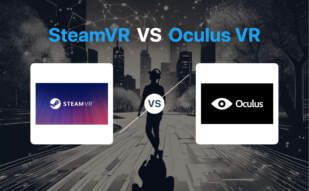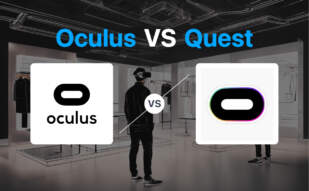For an immersive VR experience, the Valve Index wins with its high refresh rates and adjustable optics. Yet, the more affordable, user-friendly Oculus Quest 2 stands superior for casual gamers, boasting a self-contained system and a vast library of games.

Key Differences Between Valve Index and Oculus Quest 2
- Pricing: Valve Index’s full kit costs $999, whereas the Oculus Quest 2 is priced at $299.
- Operating System: Valve Index supports Windows and Linux, while Oculus Quest 2 operates on a modified version of Android.
- Controllers: Valve Index’s controllers track hand and finger positions, while Oculus Quest 2 has Touch Controllers with enhanced battery life.
- Refresh Rates: Valve Index offers a range of refresh rates (80/90/120/144Hz), Oculus Quest 2 operates at up to 120 Hz.
- Platform Availability: Valve Index is compatible with Steam, Oculus Quest 2 has a library of over 500 VR games, apps, and experiences.
| Comparison | Valve Index | Oculus Quest 2 |
|---|---|---|
| Release Date | June 28, 2019 | Flexible (Current model and updates ongoing) |
| Operating Systems | Windows, Linux | Based on Android Open Source Project (AOSP) |
| Introductory Price | $999 (Now $799 for headset-only; full kit $999) | Starting at $299 after price cut |
| Display | Dual 1440 x 1600 RGB LCDs | Singular, fast-switch LCD panel at 1832×1920 per eye |
| Frame Rates | 80/90/120/144Hz | Up to 120Hz |
| Audio | Off-ear audio solution, adjustable positioning, ultra-nearfield flat panel speakers | Positional audio with spatial real-time sound, footsteps tracking |
| Connections | USB 3.0, DisplayPort 1.2, 12V power | Dependent on used accessories and games |
| Adjustability | Head size, face angle, eye relief, and IPD | Interpupillary distance (IPD) adjustment at 58mm, 63mm, and 68mm |
| Controllers | Use 87 sensors for hand and finger positions | Improved Oculus Touch with enhanced battery life |
| External Integrations | Steam, hardware agnostic | Over 500 compatible VR games, apps, and experiences |
| Development | First headset developed and manufactured entirely in-house at Valve | Ongoing updates and long-term support committed by Meta Platforms |
| Achievements | Best VR headset by PC Gamer, most luxe VR experience | Winner of Editors’ Choice award |
What Is Valve Index and Who’s It For?
Valve Index, a second-generation, consumer virtual reality headset, is a robust device manufactured by Valve. Released on June 28, 2019, it has sold 149,000 units and is designed for long, immersive play. The Valve Index is ideal for tech-savvy consumers willing to shell out a premium for a high-end VR experience.

Pros of Valve Index
- High resolution dual 1440 x 1600 RGB LCDs
- Customizable optics and adjustable FOV offering 20 degrees more than competitors
- Innovative off-ear audio solution
- Compatible with SteamVR 1.0 and 2.0 base stations
- Controllers tracking hand and finger positions.
Cons of Valve Index
- Hefty price
- No eye tracking
- Conspicuous audio output can be a distraction
- Frustrating room-scale sensor setup
- Low supply on release date due to COVID-19.
What Is Oculus Quest 2 and Who’s It For?
Oculus Quest 2, developed by Meta Platforms, is a standalone and PC-tethered VR device. Fueled by the next-gen Snapdragon by Qualcomm, it boasts the highest resolution display in the VR market. It is a cost-effective, user-friendly device making VR more accessible to a wider audience.

Pros of Oculus Quest 2
- High-res fast-switch LCD panel
- Comprehensive Oculus Quest 2 library of games, apps, and experiences
- Positional audio for enhanced immersion
- Offers flexibility with its standalone or PC-tethered capabilities
- Future-proof with long-term support promise
Cons of Oculus Quest 2
- Not backward-compatible with Oculus Go apps and games
- Lead times for hardware and software updates
- Does not include accessories in base price
- Terms and conditions apply to certain features
- Discontinuation of 64GB variant.
Valve Index vs Oculus Quest 2: Pricing
The Valve Index is positioned as a high-end VR solution with a price of $799 for the headset only and a full kit costs $999, whereas Oculus Quest 2 offers a more affordable entry into VR, priced at $299.
Valve Index
The Valve Index, a second-generation virtual reality headset by Valve, was introduced with a price tag of $999 but is currently available for $799 for the headset only. Buying the complete kit, however, will set you back by $999. Its superior specifications, including dual 1440 x 1600 RGB LCDs, a range of-frame rates, adjustable optics, innovative off-ear audio solution, detailed tracking and customizable controllers, validate its high-end market positioning.
Oculus Quest 2
Oculus Quest 2, developed by Meta Platforms, is manufactured keeping in mind broader consumer access. Notwithstanding its high-resolution display, increased RAM, multiple storage variations, Android based operating system, enhanced Oculus Touch controllers and lightweight design, it is priced attractively at $299. Moreover, upcoming internal updates expected to improve CPU and GPU performance are included in the initially quoted price, rounding off the value-for-money proposition it offers in the competitive VR space.
Valve Index vs Oculus Quest 2: Final Verdict
The stage is set, on one side stands the mighty Valve Index offering unparalleled precision and fidelity, on the other, the Oculus Quest 2 touting standalone maneuverability and crisp resolution. The choice boils down to your virtual needs and interests. Allow us to steer you towards the optimal pick in this grand tech showdown.
Ultra-Immersive VR Enthusiasts
If your goal is to dive into VR without compromising on quality, ready to pay premium, then Valve Index doesn’t disappoint. Superior 1440 x 1600 RGB LCDs, adjustable FOV, plus the intricate tracking system breathes life into your virtual desires. Valve Index is breaching VR 1.0’s frontier, but has yet to make that leap into full-fledged VR 2.0.

AR/VR Developers & Content Creators
For developers & content creators, Oculus Quest 2 presents an accessible, ever-updating platform. It’s backed by contrivance like Snapdragon XR2, a whopping 6GB RAM, dynamic controller usage and constant software updates. Plus, it’s the choice pick if you’re eyeing for future synergy with the upcoming “Meta Quest 3”.

Mobile VR Explorers
If mobility and comfort are your priorities, Oculus Quest 2 strikes the best balance. It’s a lightweight, standalone VR headset allowing untethered exploration. Also, its competitive price point makes it a smart pick for VR novices or those on a budget.

In the grand war of Valve Index vs. Oculus Quest 2, your choice hangs on a balance of immersion vs. mobility. Valve Index demands respect with its superior visual fidelity and intricate systems, right for enthusiasts seeking fine-tuned VR experiences. Meanwhile, Oculus Quest 2 sits at the intersection of affordability, innovation, and standalone functionality, delivering a solid punch in VR’s middleweight ranks.
Grant Sullivan
Content writer @ Aircada and self proclaimed board game strategist by day, AI developer by night.





